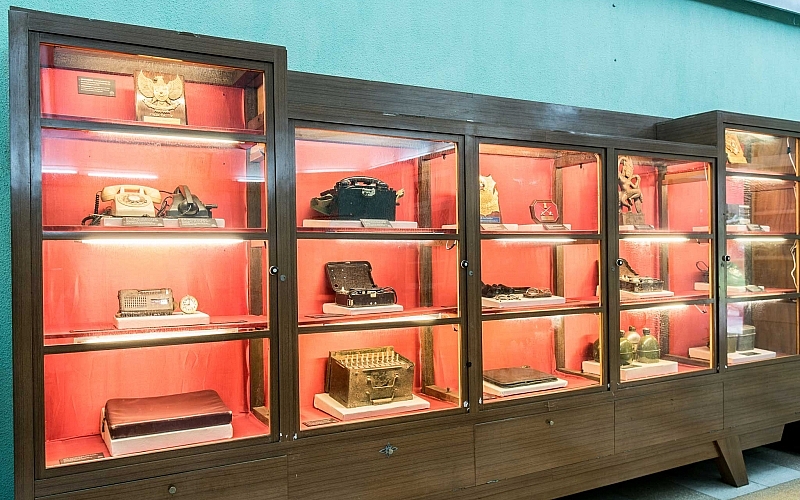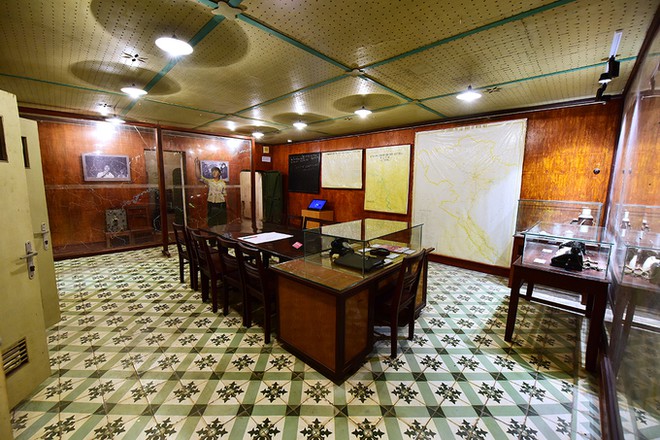Secret basements in Imperial Citadel of Thang Long
01/12/2021
Imperial Citadel of Thang Long – Vietnamese Cultural Heritage – World Cultural Heritage. Referring to the Imperial Citadel of Thang Long, we cannot help but mention the basements that played an important role in the victory of the resistance war against the US to save the country, liberate the nation, and unify the country. wonderful resounding throughout the five continents.

In 2004, when the Imperial Citadel of Thang Long opened to visitors, a special relic was also restored and introduced to everyone, that is the D67 house relic. The building was designed and built by the Command of Engineers in April 1967 on an area of more than 600m2 with the full name of the Central Military Commission’s Basement House.
At first glance, the building looks nothing special, even the scale seems to be modest compared to the image of a solid military construction. However, when entering this place, you can feel all the superiority in each design. Accordingly, the entire wall and roof are built of monolithic reinforced concrete. Specifically, the outer wall is 0.6m thick, the partition wall is 0.28m thick; The roof has three layers: the ceiling is 0.15m thick, the middle layer of sand is 0.7 – 1.15m thick, and the upper layer is 0.35m thick.
In the D67 building, the largest room with an area of 75m2 located in the middle is the meeting room of the Politburo and the Central Military Commission. This room was installed with telephone and recording equipment to ensure communication during the Ho Chi Minh campaign, the great victory in the spring of 1975.
This is where famous generals like General Vo Nguyen Giap, General Van Tien Dung… worked over 7,000 days and nights to lead and direct our army and people to wage the holy war of the nation. Besides, there are 3 other rooms including: break room, office of General Vo Nguyen Giap and office of Chief of General Staff – General Van Tien Dung. In particular, from the D67 house, there are two stairs, 45 steps on each side, the tunnel is about 1.2m wide leading down to the D67 tunnel (also known as the Central Military Commission tunnel).
Referring to the D67 tunnel, this place is also known as the “underground palace” located ten meters deep underground. This basement is not only solidly designed with many layers of doors to prevent water and heavy bombs, but also has a separate room containing venting equipment, toxic filtering, and providing clean air to be able to cope with the storms. chemical attack, biological. Inside the basement, there is a large meeting room of more than 35m2 and a duty room with an area of about 13m2 for working. The rooms in the basement are connected to generators, communication systems, logistics, food…
In particular, from September 1968 to April 30, 1975, this place held many important meetings of the Politburo, the Central Military Commission, the High Command of the Vietnam People’s Army to set campaign, strategic plan and issued combat orders with the spirit: “Fast, daring, taking advantage of every hour and every minute to rush to the front”. Among them were the decision of the general offensive and uprising during the Tet Offensive in 1968, the Road 9 campaign – Khe Sanh 1968, the Road 9 campaign – Southern Laos 1971, the 12 day and night war to destroy the North in 1972. International service to Laos and Cambodia, liberation of seas and islands, the General Offensive to liberate the South, and reunify the country in 1975.
According to historical documents, it was also at the D67 House and Tunnel, at noon on April 30, 1975, comrades Le Duan, Truong Chinh, Vo Nguyen Giap and comrades in the Politburo, the Central Military Commission, and the Ministry of National room, the General Staff rushed to the yard “The Dragon’s House” to receive the news of the liberation of the South in bursts of happiness.

Tunnel T1 is also the place where the Party Central Committee’s headquarters made historic decisions that made golden milestones in the cause of national liberation such as: deciding on the 1968 Tet Offensive, winning two wars. America’s war to destroy the North, the “Dien Bien Phu in the air” campaign, the 1975 general offensive culminating in the historic Ho Chi Minh campaign, towards liberation and national reunification. After 1975, the Central Military Commission also held a number of conferences at D67’s house to discuss the plan to build forces and the strategy to defend the Socialist Vietnam Fatherland in the new period.
To this day, in this basement, there are still traces of a very special phone, named “phone number 1”. The special feature of this phone is that it is directly connected to President Ho Chi Minh’s phone located at the stilt house of the Presidential Palace. Accordingly, “phone number 1” is placed right near the desk of the chief of staff (leader of the Operations Department) so that he can immediately answer President Ho Chi Minh when the caller asks about the military situation or encourage officers and soldiers who are on duty here. After 1975, this cellar was almost unused. In 2012, the tunnel was refurbished and repaired and in 2017 officially opened to visitors.
Source: Compilation
RELATED ARTICLES
HERITAGES OF VIETNAM